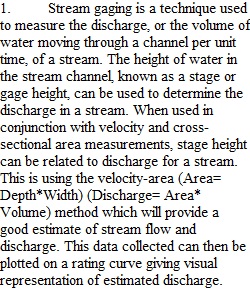


Q FE 430 Problem Set #5: flood frequency analysis submit on Canvas by Sunday of Week 6 at 11:59pm Pacific Time Objectives: 1. Evaluate probability, extreme value distribution, and return period interval as it relates to stream hydrology and structure design 2. Interpret a graphical frequency analysis of an annual peak flow series 3. Determine the probability for annual flow exceedance 4. Calculate the total storm volume using the curve NRCS method Grading Rubric: Criteria Points Possible Correct numerical solution 7 List of mathematical steps 2 Appropriate units 1 Total points for each problem 10 Total points for assignment 50 Background Information and Resources: Helpful Resources: • Instructor Overview • Textbook: Hewlett pgs. 35--37 and Chapter 7: pgs. 93-114 • Textbook: Ward and Trimble Chapter 5.5: pgs. 132-135 ** recommended Curve Number Analysis • This document Flood frequency analysis is useful to predict the probability of flood recurrence exceeding a specific discharge and the magnitude of the discharge for a given event. Use the provided data to answer the questions below. The annual peak flow series for Flynn Creek is provided in Table 1 below. The plotting position was calculated using the Weibull equation to determine the return period of each annual peak: Tr =(n+1)/m Tr is recurrence interval in years; n is the number of items in the data set; m is the ordered rank of data from largest to smallest, also known as the plotting position. Table 1: The annual peak flow series and calculated return period for Flynn Creek, Oregon using the Weibull equation. Rank (m) Water Year Discharge (csm)* Return Period (Tr) 1 1996 199.7 27.00 2 1972 197.7 13.50 3 1965 194.8 9.00 4 1961 110.9 6.75 5 1966 103.8 5.40 6 1967 99.6 4.50 7 1963 92.4 3.86 8 1964 89.6 3.38 9 1978 86.8 3.00 10 1979 83.9 2.70 11 1971 82.5 2.45 12 1959 75.4 2.25 13 1980 72.5 2.08 14 1970 71.1 1.93 15 1990 68.3 1.80 16 1962 65.4 1.69 17 1968 64 1.59 18 1969 64 1.50 19 1960 61.2 1.42 20 1997 57.7 1.35 21 1995 52.6 1.29 22 1991 44.9 1.23 23 1994 44.9 1.17 24 1977 35.6 1.13 25 1992 32.1 1.08 26 1993 23.1 1.04 *csm = cubic feet per second per square mile = cfs/mi2. csm is a unit-area discharge. Figure 1: Cumulative frequency distribution using log Pearson-Type III analysis for Flynn Creek with peak flow in csm and recurrence interval in years. Problems PART ONE Answer the following questions using the cumulative frequency distribution for Flynn Creek in Figure 1 and Table 1. You will find useful equations in the Instructor Overview for this week. (csm = cubic feet per second per square mile = cfs/mi2) 1. The average annual peak flow for Flynn Creek is 84 csm. Using the frequency analysis in Figure 1, deter-mine the return period, Tr , of the average annual peak flow. Estimate the return period off the line that is fitted through the data points. Report the return period, Tr, in years. 2. Using the cumulative frequency distribution in Figure 1 for Flynn Creek, what is the unit-area discharge in csm for the 25-, 50-, and 100-year return period flows? Estimate the unit-area discharge off the line that is fitted through the data points. For example, the unit-area discharge for a 5-year return flow is approximate-ly 98 csm. 3. For any water year, determine the probability that the annual peak discharge will be at least 60 csm in Fly-nn Creek. Do the same for 120 csm. Estimate using the line that is fitted through the data points in Figure 1. PART TWO Using the NRCS curve method estimate the depth and volume of discharge from 5 inches of rainfall on two different locations. You will need to use equations in section 5.5 of Ward and Trimble (equations 5.3 and 5.4). You will also need Table 5.1 and Appendix D above. 4. 20 acres grass area in an urban part in Winona, AZ under antecedent moisture conditions (AMC) II. 5. 50 acres wood forest with good cover in Valent, CO under antecedent moisture conditions (AMC) II.
View Related Questions